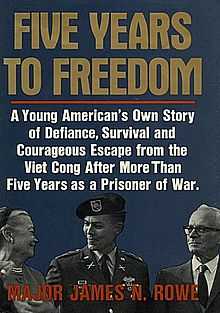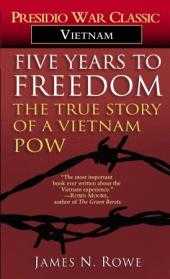James N. Rowe
| James Nicholas Rowe | |
|---|---|
 then-Major James N. Rowe on the cover of his book, Five Years to Freedom | |
| Nickname | "Nick" |
| Born |
February 8, 1938 McAllen, Texas |
| Died |
April 21, 1989 (aged 51) Quezon City, Philippines |
| Allegiance | United States of America |
| Service/branch | United States Army |
| Years of service |
1963–74 1981–89 |
| Rank | Colonel |
| Commands held |
5th Special Forces Group – Battalion Commander Joint U.S. Military Advisory Group – Chief, Army Division |
| Battles/wars |
Cold War *Vietnam War *Filipino Insurgency |
| Awards |
Silver Star Legion of Merit Bronze Star – 2 Purple Heart – 2 Meritorious Service Medal National Defense Service Medal Vietnam Service Medal Army Service Ribbon Republic of Vietnam Gallantry Cross Unit Citation |
| Other work | Author |

James Nicholas "Nick" Rowe (February 8, 1938 – April 21, 1989) was a United States Army officer and one of only thirty-four American prisoners of war to escape captivity during the Vietnam War.[1] Colonel Rowe was credited with developing the rigorous Survival, Evasion, Resistance and Escape (SERE) training program taught to high-risk military personnel (such as Special Forces and aircrews) and the U.S. military doctrine which institutionalizes these techniques and principles to be followed by captured personnel.
Personal life
Rowe was born in McAllen, Texas on February 8, 1938 to Lee Delavan and Florence (Survillo) Rowe. He grew up in McAllen, joining his local DeMolay chapter, and graduated from McAllen High School in 1956 before leaving for the United States Military Academy at West Point, New York.
Rowe married Jane Rowe on December 27, 1969.
Military service
Rowe graduated from West Point in 1960 and was commissioned as a second lieutenant in the United States Army. In 1963, First Lieutenant Rowe was sent to the Republic of Vietnam and assigned as Executive Officer of Detachment A-23, 5th Special Forces Group, a 12-man "A-team". Located at Tan Phu in An Xuyen Province, A-23 organized and advised a Civilian Irregular Defense Group camp in the Mekong Delta region of Vietnam. On October 29, 1963, after only three months in country, Rowe was captured by Viet Cong elements along with Captain Humberto "Rocky" R. Versace and Sergeant Daniel L. Pitzer. Separated from his comrades, Rowe spent 62 months in captivity with only brief encounters with fellow American POWs. Rowe was held in the U Minh Forest, better known as the "Forest of Darkness," in extreme southern Vietnam. During most of his five years in captivity Rowe was held in a cage. He managed to escape on December 31, 1968, after overpowering his guard, he was picked up by a UH-1 helicopter. Rowe was promoted to Major during captivity.[2] In 1971, he authored the book, Five Years to Freedom, an account of his years as a prisoner of war. In 1974, he retired from the Army.
In 1981, Rowe was recalled to active duty as a lieutenant colonel to design and build a course based upon his experience as a POW. Survival, Evasion, Resistance, and Escape (SERE) is now a requirement for graduation from the U.S. Army Special Forces Qualification Course. SERE is taught at the Colonel James "Nick" Rowe Training compound at Camp Mackall, North Carolina. It is considered by many to be the most important advanced training in the special operations field. Navy, Air Force and Marine Special Operations personnel all attend variations of this course taught by their respective services. By 1987, Colonel Rowe was assigned as the chief of the Army division of the Joint U.S. Military Advisory Group (JUSMAG), providing counter-insurgency training for the Armed Forces of the Philippines. Working closely with the Central Intelligence Agency and intelligence organizations of the Republic of the Philippines, he was involved in its nearly decade-long program to penetrate the New People's Army (NPA), the communist insurgency that threatened to overthrow the Philippines' government.
By February 1989, Colonel Rowe had acquired intelligence information which indicated that the communists were planning a major terrorist act. He warned Washington that a high-profile figure was about to be assassinated and that he himself was second or third on the assassination list. At around 7:00 in the morning of April 21, 1989, as he was being driven to work at the Joint U.S. Military Advisory Group headquarters in an armoured limousine, Colonel Rowe's vehicle was hit by gunfire from a .45 caliber pistol and an M16 rifle near a corner of Tomas Morato Street and Timog Avenue in Quezon City.[3] Twenty-one shots hit the vehicle; one round entered through an unarmoured portion of the vehicle frame and struck Colonel Rowe in the head, killing him instantly, while chauffeur Joaquin Vinuy was wounded. Years later, the New People's Army eventually claimed responsibility for his assassination. Filipino nationals Juanito T. Itaas (principal) and Donato B. Continente (accomplice) were convicted by a Philippine court and sentenced to 16 years imprisonment; Continente was released in 1995 under an amnesty programme of the Philippine government.[4]
Rowe was buried on May 2, 1989 in Section 48 of Arlington National Cemetery.
Politics
Rowe was a staunch conservative and a strong critic of George McGovern in the 1972 presidential campaign. He ran as a Republican for the office of Texas Comptroller in 1974 but was easily defeated by Democrat Bob Bullock in a strongly Democratic year because of the Watergate scandal. Bullock would receive 1,099,599 votes (71.6%) to Rowe's 419,657 (27.3%). A third party candidate earned the remaining 16,383 (1%) votes. Rowe did not run for office again and Bullock became a popular two-term lieutenant governor.[5]
Memorials
- James "Nikki" Rowe High School and a major street Col. Rowe Blvd. Formally known as 2nd St. in McAllen, Texas are named in his memory.
- The JROTC Drill Teams (Rowe's Rifles, Rowe's Rangers) and Shooting Team (Rowe's Rangers) of McAllen High School were named in his honor well before he died.
- A training facility, Rowe Hall, at the US Army Intelligence Center and School, Fort Huachuca, Arizona was named in his honor.
- Having been a member of the Order of DeMolay as a teenager, he was recognized with both the DeMolay Legion of Honor, the highest honor DeMolay confers, and was inducted into the International DeMolay Hall of Fame.
- An Order of Knighthood priory of DeMolay International in the state of Florida is named in his memory.
- The obstacle course on Camp MacKall, arguably the hardest obstacle course in the Army, is named the "Nasty Nick"
- An office facility, the Rowe Building, of the Joint United States Military Assistance Group — Philippines, US Embassy, Manila, was named in his honor.
- The Colonel James N. "Nick" Rowe Memorial, located in Veteran's Memorial Park in Union Beach, New Jersey, was dedicated on October 9, 2004, by friends, classmates from the West Point Class of 1960, and comrades-in arms, Among attendees were Major General Ted Crowley (a classmate) and Ross Perot and Colonel Rowe's widow and children.
See also
References
- ↑ Patterson, Michael Robert. "James Nicholas Rowe". Retrieved August 1, 2007.
- ↑ "Case Synopsis: Rowe, James Nicholas "Nick"". Retrieved August 1, 2007.
- ↑ Magay-dris, Tomasita B. "People vs. Continente, et al.". Retrieved August 1, 2007.
- ↑ Sampley, Ted. "U.S. Gives Philippines Lukewarm Reminder to Keep Col. Rowe's Killers in Jail". Retrieved August 1, 2007.
- ↑ Garza, Alicia A. "Handbook of Texas Online — Rowe, James Nicholas". Retrieved October 20, 2009.
External links
- A tribute page on James N. Rowe
- Random House author page on James N. Rowe
- An account of James N. Rowe's rescue by a US Army helicopter crew
- Statement by Press Secretary Fitzwater on the Assassination of Lieutenant Colonel James N. Rowe in the Philippines
- Col. James 'Nick' Rowe Priory homepage
|